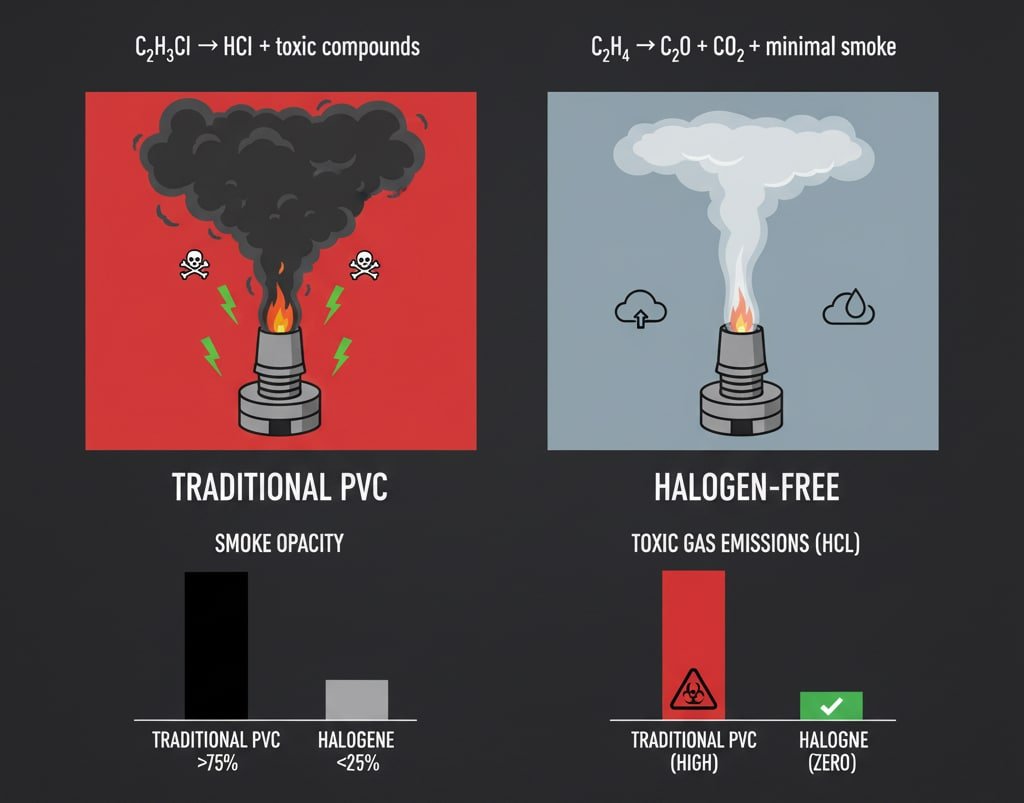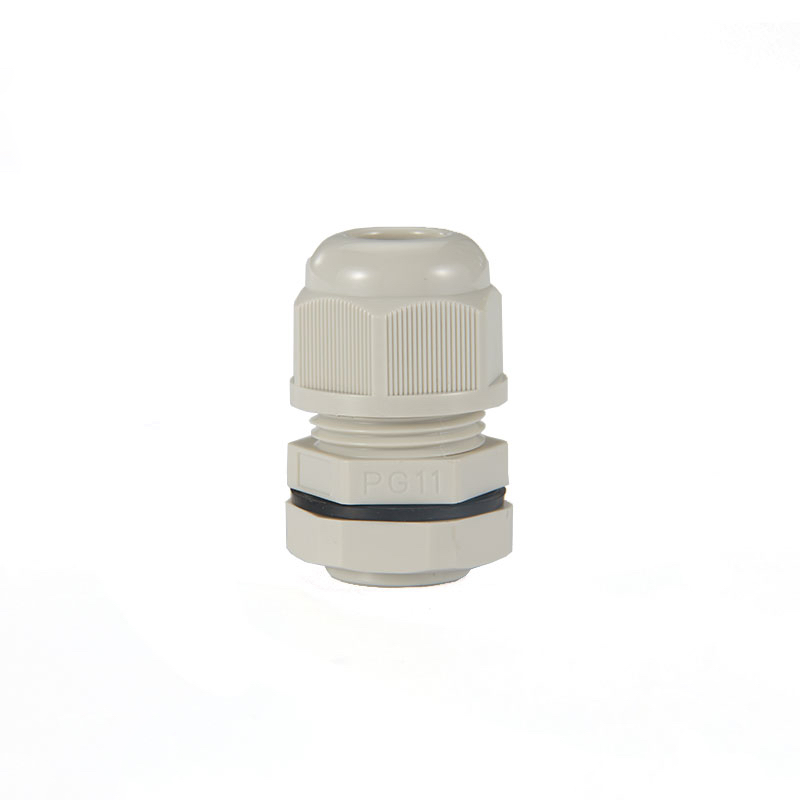Introduction
Ever wondered why halogen-free cable glands are becoming the gold standard in modern electrical installations? The answer lies deep within their molecular structure. As someone who’s spent over a decade in the cable connector industry, I’ve witnessed firsthand how polymer chemistry revolutionizes safety standards.
Halogen-free cable glands utilize advanced polymer compounds that eliminate toxic chlorine and bromine atoms, providing superior fire safety while maintaining excellent mechanical properties. This breakthrough in material science has transformed how we approach electrical safety in critical applications.
The shift toward halogen-free solutions isn’t just a trend—it’s a necessity. When David, a procurement manager from a major automotive plant in Detroit, contacted us last year about upgrading their entire cable management system, his primary concern was worker safety during potential fire incidents. This conversation sparked my deeper investigation into the fascinating world of halogen-free polymer chemistry.
Table of Contents
- What Are Halogen-Free Polymers in Cable Glands?
- How Do Halogen-Free Compounds Enhance Fire Safety?
- What Are the Key Polymer Types Used?
- Why Choose Halogen-Free Over Traditional Materials?
- FAQs About Halogen-Free Cable Glands
What Are Halogen-Free Polymers in Cable Glands?
Halogen-free polymers are synthetic compounds specifically engineered without chlorine, bromine, fluorine, or iodine atoms, designed to eliminate toxic gas emissions during combustion.

The Science Behind Halogen-Free Chemistry
The fundamental difference lies in the molecular backbone. Traditional PVC cable glands contain chlorine atoms bonded to carbon chains. When exposed to high temperatures, these bonds break, releasing hydrogen chloride gas1—a corrosive and toxic compound that poses serious health risks.
Halogen-free polymers, on the other hand, utilize alternative molecular structures:
- Polyolefin-based compounds: Built on carbon-hydrogen chains without halogen substitution
- Modified polyethylene: Enhanced with flame-retardant additives that don’t contain halogens
- Thermoplastic elastomers: Combining flexibility with halogen-free fire resistance
Real-World Application Success
Last month, Hassan, who manages a petrochemical facility in Abu Dhabi, shared his experience with our halogen-free cable glands. During a routine safety inspection, inspectors specifically praised the facility’s commitment to using halogen-free materials throughout their electrical infrastructure. This wasn’t just about compliance—it was about creating a safer working environment for his 200+ employees.
How Do Halogen-Free Compounds Enhance Fire Safety?
Halogen-free compounds enhance fire safety by producing non-toxic smoke with reduced opacity2 and eliminating corrosive gas emissions that can damage equipment and harm personnel.
The Combustion Chemistry Advantage
When traditional halogenated materials burn, they undergo a complex chemical reaction:
Traditional PVC Combustion:
- C₂H₃Cl → HCl + toxic compounds
- High smoke density
- Corrosive gas production
- Equipment damage potential
Halogen-Free Combustion:
- C₂H₄ → H₂O + CO₂ + minimal smoke
- Low smoke density
- Non-corrosive emissions
- Reduced equipment damage

Performance Metrics That Matter
| Property | Traditional PVC | Halogen-Free |
|---|---|---|
| Smoke Density | >75% | <25% |
| HCl Emission | High | Zero |
| Oxygen Index3 | 26-28 | 28-35 |
| Flame Spread | Moderate | Low |
Advanced Flame Retardant Systems
Modern halogen-free cable glands incorporate sophisticated flame retardant mechanisms:
- Intumescent Systems4: Expand when heated, creating insulating char layers
- Mineral Fillers: Aluminum trihydrate and magnesium hydroxide release water vapor
- Phosphorus Compounds: Promote char formation without toxic emissions
What Are the Key Polymer Types Used?
The primary polymer types in halogen-free cable glands include modified polyolefins, thermoplastic polyurethanes, and specialized elastomer blends, each offering unique performance characteristics.
Polyolefin-Based Systems
Polyolefins form the backbone of most halogen-free cable glands due to their excellent chemical resistance and processability:
- Low-Density Polyethylene (LDPE): Provides flexibility and chemical resistance
- High-Density Polyethylene (HDPE): Offers superior mechanical strength
- Polypropylene (PP): Delivers excellent temperature resistance
Thermoplastic Elastomers (TPE)
TPEs combine the processing advantages of thermoplastics with the performance properties of rubber:
- Styrenic Block Copolymers: Excellent low-temperature flexibility
- Polyolefin Elastomers: Superior chemical resistance
- Thermoplastic Polyurethanes: Outstanding abrasion resistance
Specialized Additive Systems
The magic happens when we combine base polymers with carefully selected additives:
Flame Retardant Additives:
- Aluminum trihydrate (ATH): 40-60% loading
- Magnesium hydroxide: 50-65% loading
- Red phosphorus: 8-15% loading
Performance Enhancers:
- UV stabilizers for outdoor applications
- Antioxidants for thermal stability
- Processing aids for manufacturing efficiency
Why Choose Halogen-Free Over Traditional Materials?
Halogen-free cable glands offer superior safety profiles, environmental benefits, and long-term cost advantages despite slightly higher initial investment costs.
Comprehensive Safety Benefits
The safety advantages extend far beyond fire scenarios:
- Reduced Toxicity: Zero halogen content eliminates toxic gas risks
- Improved Visibility: Low smoke production maintains evacuation routes
- Equipment Protection: Non-corrosive emissions prevent secondary damage
- Regulatory Compliance: Meets increasingly strict international standards
Environmental Impact Considerations
Environmental consciousness drives many of our customers’ decisions. Halogen-free materials offer:
- Recyclability: Easier processing in recycling facilities
- Reduced Environmental Toxicity: No persistent organic pollutants
- Sustainable Manufacturing: Lower environmental impact during production
Economic Analysis
While initial costs may be 15-20% higher, the total cost of ownership often favors halogen-free solutions:
Cost Factors:
- Insurance Premiums: Potential reductions for safer materials
- Maintenance: Reduced corrosion-related replacements
- Compliance: Avoiding future regulatory penalties
- Brand Value: Enhanced reputation for safety commitment
Industry Adoption Trends
Major industries are rapidly transitioning to halogen-free solutions:
- Transportation: Railways and automotive applications
- Marine: Ship and offshore platform installations
- Construction: High-rise buildings and public facilities
- Industrial: Chemical processing and manufacturing plants
Conclusion
The polymer chemistry revolution in halogen-free cable glands represents more than just material innovation—it’s a fundamental shift toward safer, more sustainable electrical infrastructure. Through advanced molecular engineering, we’ve eliminated toxic emissions while maintaining the mechanical and electrical properties essential for reliable performance.
As regulations tighten and safety awareness grows, halogen-free cable glands aren’t just an option—they’re becoming the standard. At Bepto, we’re proud to lead this transformation, offering our customers cutting-edge solutions that protect both people and equipment. The science is clear, the benefits are proven, and the future is halogen-free. 😉
FAQs About Halogen-Free Cable Glands
Q: What is the main difference between halogen-free and regular cable glands?
A: Halogen-free cable glands use polymer compounds without chlorine, bromine, fluorine, or iodine atoms, eliminating toxic gas emissions during fire while regular cable glands typically use PVC that releases harmful hydrogen chloride gas when burned.
Q: Are halogen-free cable glands more expensive than traditional ones?
A: Yes, halogen-free cable glands typically cost 15-20% more initially, but they often provide better total cost of ownership through reduced insurance premiums, lower maintenance costs, and compliance with stricter safety regulations.
Q: Do halogen-free cable glands perform as well mechanically?
A: Absolutely. Modern halogen-free polymers match or exceed traditional materials in mechanical properties like tensile strength, impact resistance, and temperature performance while providing superior fire safety characteristics.
Q: Which industries require halogen-free cable glands?
A: Transportation (railways, automotive), marine applications, high-rise construction, hospitals, schools, and chemical processing facilities increasingly require or prefer halogen-free materials for enhanced safety and regulatory compliance.
Q: How can I identify if a cable gland is truly halogen-free?
-
Review the health and safety information for hydrogen chloride gas from authoritative sources like the CDC or NIOSH. ↩
-
Learn about the standard test methods used to measure the density and obscurity of smoke generated by burning materials. ↩
-
Understand how the Oxygen Index test (ASTM D2863) is used to measure the minimum oxygen concentration required to support combustion. ↩
-
Explore the chemical process behind intumescent systems, which swell and form a protective char layer when exposed to heat. ↩
-
Access the official documentation for the international standard that specifies the test method for determining halogen acid gas content. ↩



